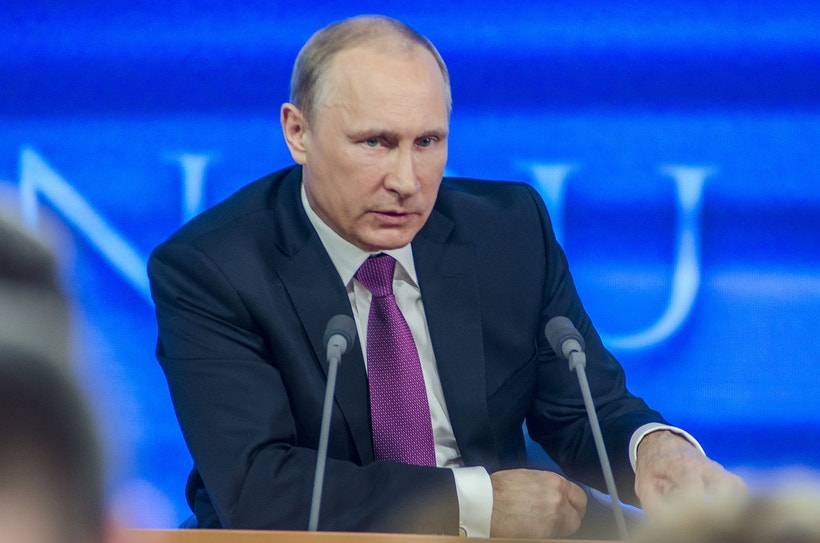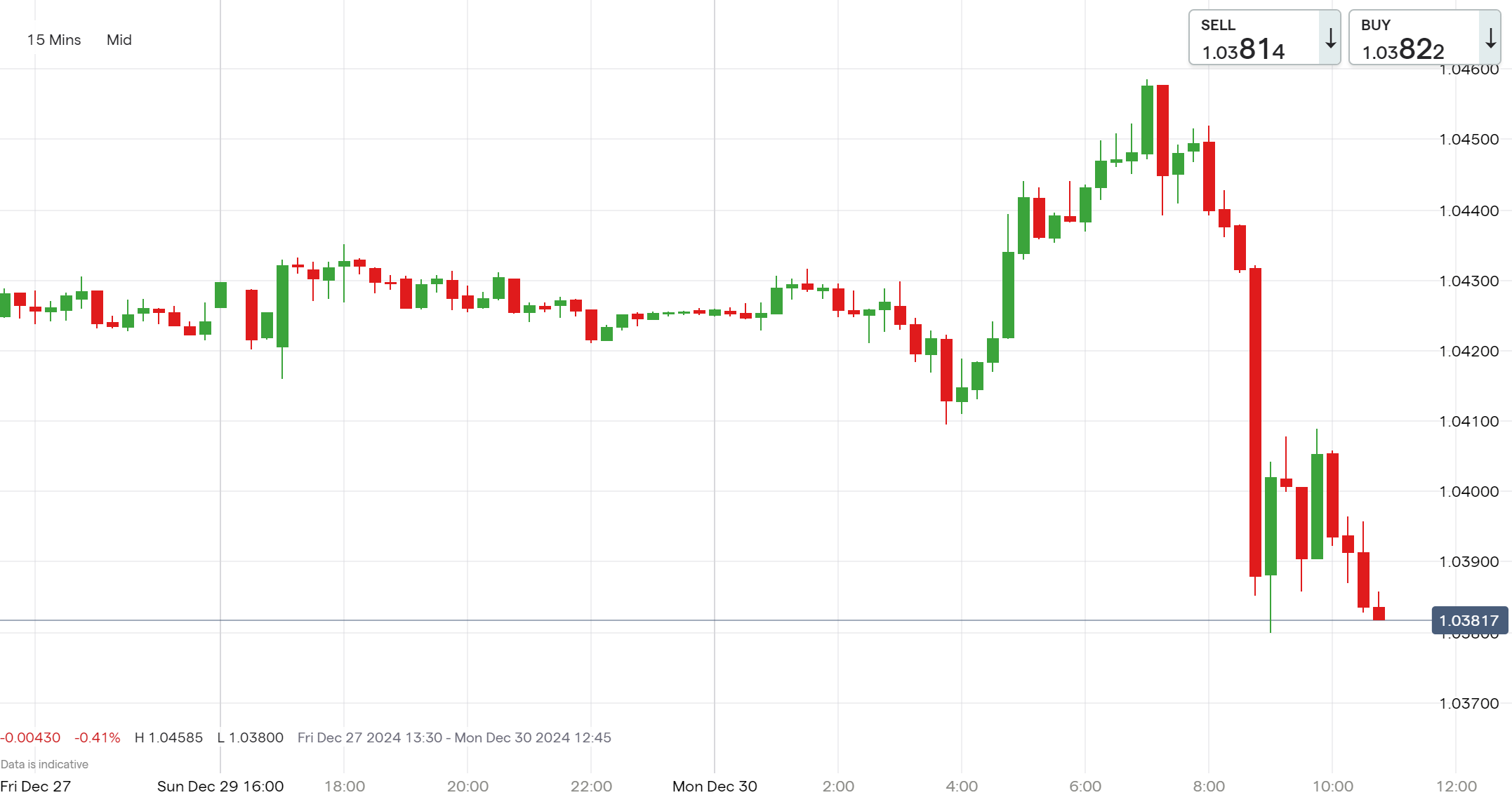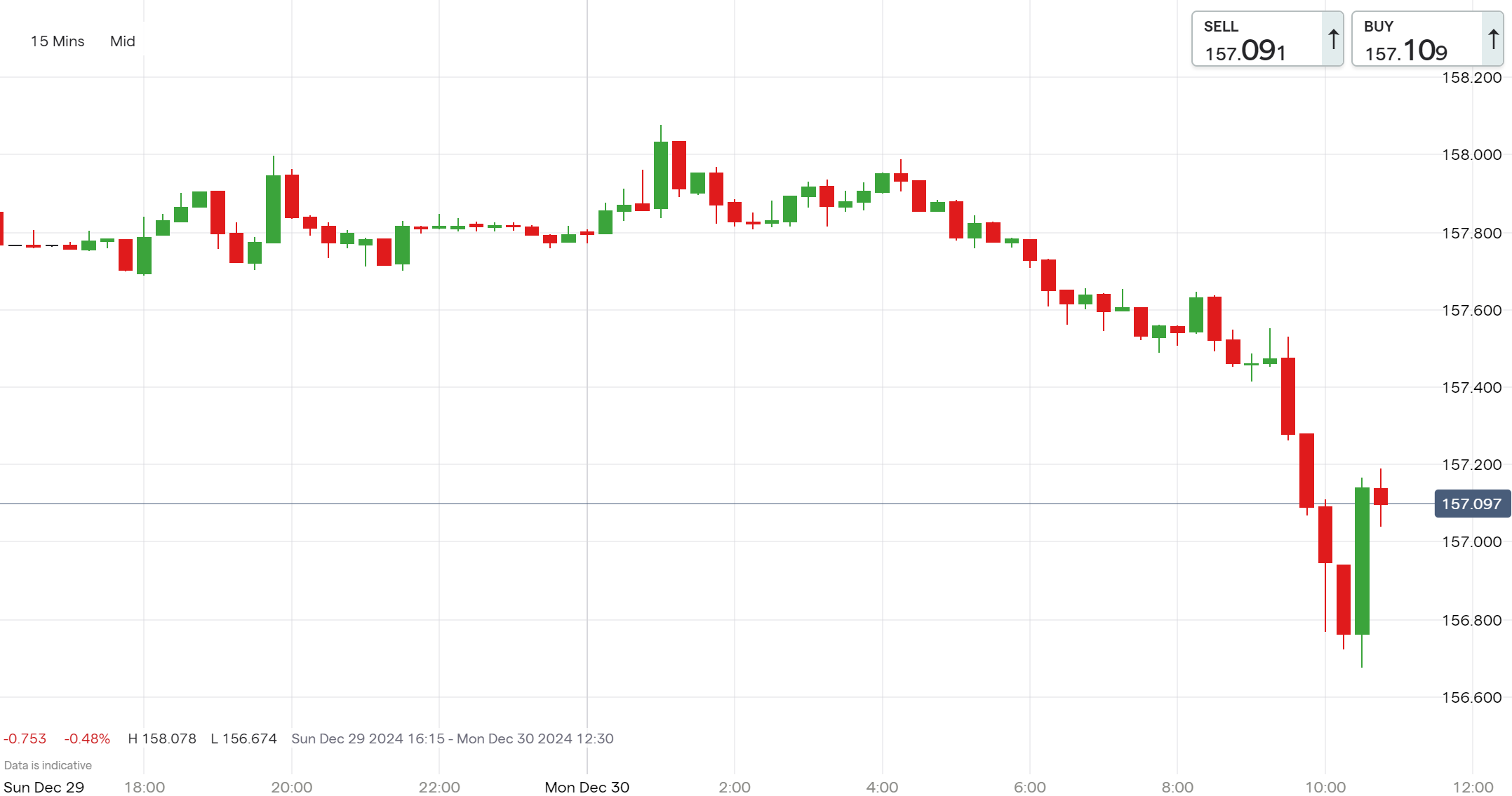Euro softens and yen strengthens as Russia rejects Ukraine peace plan
Euro slips amid ECB rate cuts, geopolitical tensions, and shifting energy dynamics, while yen strengthens as a safe haven asset amid market volatility and potential BOJ rate hikes.

Key points
- EUR/USD drops below 1.0400 amid ECB rate cuts and geopolitical tensions
- ECB expected to implement four more 25bps rate cuts in 2025
- Russian rejection of Ukraine peace plan adds uncertainty to euro outlook
- USD/JPY sees yen strength at 156.72 as BOJ assesses rate stance
- Eurozone energy challenges may impact inflation and trade balances
EUR/USD: euro sinks below 1.0400
The euro has held a bearish outlook, hitting a low 1.0371, while staying above its late-November two-year low. The ECB made four 25 basis points rate cuts in 2024 and is expected to make another four in 2025. The euro has dropped nearly 6% this year due to differing central bank policies. While the ECB plans gradual rate cuts, the US Federal Reserve reduced its 2025 rate cut projections from four to two, boosting the dollar against the euro.
Additionally, uncertainty over potential US policy changes under President-elect Donald Trump further pressures the euro's outlook. Furthermore, Russia's rejection of Donald Trump's Ukraine peace plan introduces significant geopolitical tension, and the rejection could lead to uncertainty in European financial markets, as EU countries play a strong role in the proposed peacekeeping efforts in Ukraine.
EUR/USD price history

USD/JPY: yen strengthens against the dollar below 157.00
The Japanese yen saw some strength against the US dollar hitting 156.72 as investors evaluated the Bank of Japan's (BOJ) interest rate stance. During their December meeting, BOJ policymakers discussed a possible rate hike, with some members indicating conditions might warrant it. However, rates were kept steady at 0.25%, with Governor Kazuo Ueda wanting more data on wage growth and future US economic policy clarity.
Externally, the yen is pressured by a robust US dollar, supported by rising Treasury yields despite recent US Federal Reserve rate cuts. Additionally, Trump's Ukraine peace plan being rejected by Russia could also affect the yen. The yen, often seen as a safe-haven currency, might see increased demand as investors look for stability amid the conflict. The ongoing tensions in Eastern Europe could drive risk-averse investors to buy yen, increasing its value against other currencies.
USD/JPY price history

Europe Braces for Disruption with Russia-Ukraine Gas Deal Expiry
The current shift toward increased U.S. LNG exports due to risks in Russian gas supply, the euro could be affected in many ways. As European nations brace for disruptions in Russian natural gas, they are likely to turn to U.S. LNG, which could drive up energy costs across the continent. Elevated energy prices can exacerbate inflationary pressures within the Eurozone, potentially affecting consumer spending and economic growth.
An increased reliance on U.S. LNG imports may affect the Eurozone's trade balance by widening trade deficits in countries that are heavily dependent on external energy sources. This scenario could complicate the European Central Bank's (ECB) monetary policy efforts, especially if inflation rises above target levels, potentially necessitating interest rate adjustments. Moreover, the expiration of the Russia-Ukraine gas transit deal and the accompanying regional tensions may lead to broader economic uncertainty in Europe, which could undermine investor confidence and result in euro volatility. Thus, the current energy dynamics may create economic challenges for the Eurozone, influencing inflation, trade, and currency stability, thereby impacting the euro's performance in foreign exchange markets.
What’s next for EUR/USD and USD/JPY?
The European Central Bank's (ECB) series of rate cuts, with more expected in 2025, contrasts with the US Federal Reserve's reduction in its rate cut projections, leading to dollar domination within the pair. Additional pressure on the euro stems from geopolitical uncertainties, notably Russia's rejection of Donald Trump's Ukraine peace plan, which heightens tension in European financial markets given the EU's involvement in peacekeeping efforts. Compounding these challenges, the looming expiration of the Russia-Ukraine gas transit deal could escalate energy costs in Europe, driving inflation and complicating ECB monetary policy as the region begins to rely more on US LNG imports. This could test the ECB's ability to manage economic stability and might lead to increased euro volatility.
Conversely, the Japanese yen has strengthened against the dollar. The yen benefits from its status as a safe-haven currency, attracting investors amid geopolitical tensions and potential instability in Eastern Europe. Although the robust US dollar, bolstered by rising Treasury yields, poses external pressure, the yen's appeal could grow as investors seek stability. The potential for the BOJ to consider rate hikes, depending on clearer economic data, further supports the yen's strength. Overall, while the euro may face challenges from energy supply issues and geopolitical tensions, it could stabilize if the ECB effectively manages inflation and trade impacts. Meanwhile, the yen could strengthen as a safe-haven asset amid market volatility, although its gains might be tempered by external pressures such as robust US dollar dynamics and domestic economic considerations.
How to trade EUR/USD and USD/JPY
- Open an account to get started, or practice on a demo account
- Choose your forex trading platform
- Open, monitor, and close positions on EUR/USD and USD/JPY
Trading forex requires an account with a forex provider like tastyfx. Many traders also watch major forex pairs like EUR/USD and USD/JPY for potential opportunities based on economic events such as inflation releases or interest rate decisions. Economic events can produce more volatility for forex pairs, which can mean greater potential profits and losses as risks can increase at these times.
You can help develop your forex trading strategies using resources like tastyfx’s YouTube channel. Our curated playlists can help you stay up to date on current markets and understanding key terms. Once your strategy is developed, you can follow the above steps to opening an account and getting started trading forex.
Your profit or loss is calculated according to your full position size. Leverage will magnify both your profits and losses. It’s important to manage your risks carefully as losses can exceed your deposit. Ensure you understand the risks and benefits associated with trading leveraged products before you start trading with them. Trade using money you’re comfortable losing. Past performance is not indicative of future results.
